Podcast: Play in new window | Download (Duration: 23:28 — 18.5MB)
This week’s episode is all about echinoderms, or at least the star-shaped echinoderms! Thanks to Llewelly for the suggestion about feather stars and crinoids!
A very pretty starfish:
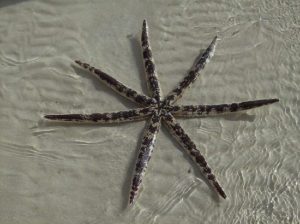
Crown of thorns starfish. Do not touch:
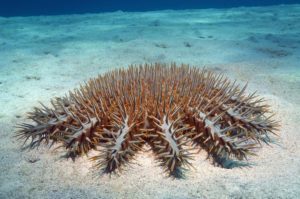
Pumpkin starfish or orange throw pillow? YOU DECIDE:
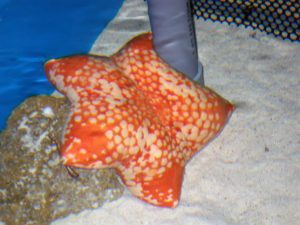
Sea daisies. Not much to look at tbh:
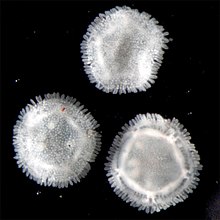
A banded arm brittle star:
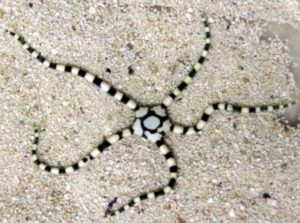
Ruby brittle stars:
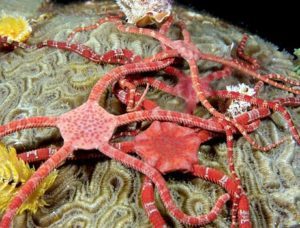
Brittle stars riding around in a jelly:
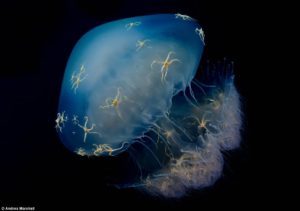
A basket star:
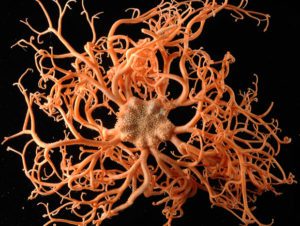
Basket stars got TEETH THINGS:
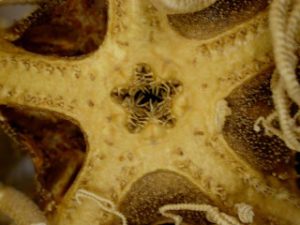
A stemmed crinoid:
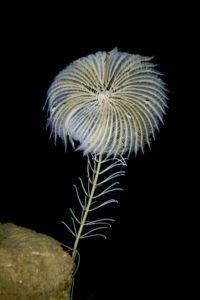
A lovely feather star:
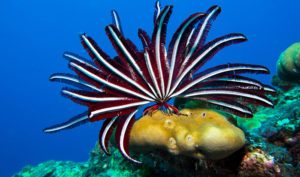
Further reading:
Echinoblog, a really amazing resource and so much fun to browse
Show transcript:
Welcome to Strange Animals Podcast. I’m your host, Kate Shaw.
This week we’re going to look at some marine animals that most people barely think about, but which are really interesting. It was going to just be about starfish and maybe one other animal, but while I was still researching starfish, listener Llewelly suggested I cover feather stars and crinoids. They’re related to starfish, so I thought I’d tack them on. And if you talk about starfish, you really have to talk about brittle stars too, and if you talk about brittle stars you have to talk about basket stars. Basically, I had to stop myself from breaking this episode into two big episodes about echinoderms. It’s just the stars this time.
Before we get into echinoderms, though, a quick note about my schedule. Next week I’m going on a trip to Paris, France! I know it sounds like I’m rich and just travel as my whim takes me, but actually I just have really generous relatives. A week and a half after I return from Paris, I’ll be in Atlanta, Georgia for DragonCon, where I’ll be on a panel about podcasting. In other words, I won’t be around much on social media for the rest of August, but don’t worry, I’ll have episodes recorded and scheduled to run normally while I’m gone.
Okay, now let’s get into echinoderms. Echinoderms include sand dollars, sea urchins, starfish, and many others, and every single echinoderm lives in the ocean. Many of them can regenerate limbs and other body parts, and instead of blood they have a water vascular system. In most echinoderms, seawater enters the body through slits or pores, then travels through canals within the body to transport oxygen to cells and waste products out of cells. Echinoderms have internal skeletons made of calcium carbonate, but they’re invertebrates because they don’t have a backbone. Heck, technically they don’t even have a back.
Echinoderms show radial symmetry, which means their bodies are roughly the same in all directions instead of having a clear front and rear. The echinoderms we’re talking about this week are ones that also exhibit pentaradial symmetry, which means they have five sides. And the best-known echinoderms out there are starfish. There are about 1,500 species of starfish known, and some of them are really weird and some are only kind of weird. Most have five arms but some have a whole lot more.
Starfish are members of the class Asteroidea, which just delights me. A better name for them is sea star, since they’re not fish at all. Starfish have been around for at least 450 million years, but in 2012 paleontologists found a fossil of the oldest known ancestor of starfish in the mountains of Morocco. It’s about 515 million years old, from the Cambrian period. It was only about an inch and a half long, or 4 cm, and looked similar to the modern-day sea lily, or crinoid. If you recall, the Cambrian period was when life was expanding rapidly in the oceans and evolving sometimes quite strange body plans. You know, like things with FIVE LEGS.
Most starfish have ossicles in their skin, little hard beads of calcium carbonate that help protect the animal. In some starfish, the ossicles are more like spines or even spikes. Although cartoons of starfish usually make them look like their legs are always exactly star-shaped, the legs are actually quite flexible. If a starfish is flipped upside down, it bends a couple of its legs down to flip itself back over.
The starfish’s mouth is in the very center of its body, the part in the middle of the legs, known as the disc. Different starfish use their mouths differently. That sounds confusing, but just hang on, because things are about to get weird and gross.
Starfish are primarily predators. Some starfish just swallow their prey whole and digest it in the stomach. Pretty normal. But other starfish—look, I don’t know how to tell you this, so I’ll just say it. They turn their stomach inside out, called eversion, squish it around the prey, and start the digestive process. Part of the stomach stays inside the body, and when the prey has been digested enough that’s it sort of a lumpy soup, the starfish retracts its everted stomach and the food back into the body. This means that the starfish can eat prey that’s bigger than it is.
A lot of starfish eat bivalves of various kinds, like clams. Say a starfish finds a clam and wants to eat it. The clam is closed up tight and starfish don’t have teeth or claws to break the clam open. But starfish do have tiny tubes on the bottoms of their legs, called tube feet. These tubes act like suction cups, although they actually stick to things with a chemical reaction. So the starfish latches onto both shells of the bivalve with its tube feet and pulls. It probably isn’t strong enough to pull the clam open completely, but it doesn’t need to. It just needs a little space so it can evert its stomach and squish it into the clam’s shell. Then it releases digestive enzymes and the clam is doomed.
Starfish can’t move very fast, and lots of animals eat them. But they can regenerate lost legs if some of them are bitten off. The starfish doesn’t have a brain, although it does have a nerve net. Plus, it has sensory bundles at the ends of its arms that can detect smells, along with eye spots at the end of each leg. The eye spots basically just detect light and darkness and they don’t actually look like eyes, which is a good thing because that would be terrifying.
Starfish arms, or legs, are properly called rays. I will continue to confuse everyone by calling them arms or legs depending on which word sounds better to me at the time.
So let’s get down to the nitty-gritty. What is the biggest starfish? What is the weirdest starfish? Could a starfish actually kill you, and I don’t mean by making you faint with terror and drown, which is what would happen to me if I accidentally touched one.
Let’s start with the biggest starfish. Starfish don’t actually get all that enormous. Even the biggest ones are typically only about two feet across, or 60 cm. The sunflower star can grow more than three feet across, or over a meter, and can weigh up to 11 pounds, or 5 kilograms. AND it has a ridiculous number of arms, up to 24 of them.
Sunflower stars can be purple, red, pink, brown, orange, yellow, or even white. They live on the sea bed along the Pacific coast, usually where it’s shallow but sometimes nearly 1500 feet deep, or over 450 meters. Young sunflower stars only have five arms, but as they get older they grow more arms. One genus of starfish, commonly called Heliaster, looks similar to the sunflower star even though it’s not that closely related to it, but some individuals can have up to 50 legs.
Recently, a bed of 350 fossil starfish were found in Florida, so well preserved that paleontologists were able to identify them as Heliaster michrobachius, which is still around today. But it lives off the western coast of Central and South America, from Mexico all the way down to Chile—but it’s not found anywhere else. So what were they doing in Florida three million years ago?
Remember the Great American Interchange, where the isthmus of Panama formed, connecting North and South America and allowing animals from both places to spread into the other continents? Before then, North America was separate from South America, so Heliaster undoubtedly lived along North America’s southern coast. After the isthmus formed, currents, salinity, and many other factors changed, which probably led to Heliaster dying out in the Atlantic side of the continent. Fortunately, it survived in the Pacific side.
So, what is the weirdest starfish? It’s really hard to decide. All starfish are weird, frankly. Labidiaster annulatus can grow up to two feet across, or 60 cm, and has 40 to 45 long, thin legs with sharp spines that can actually grab prey. The starfish holds its legs out and wriggles them like fishing lines, and when a little fish or an amphipod comes close, the spines snag it. The starfish wraps its arms around the prey and pulls it to its mouth, where it everts its stomach and starts digesting.
The crown-of-thorns starfish mostly eats coral polyps and is covered with thorny spines that are venomous. It can have up to 21 arms and is the same size as Labidiaster, but with a thicker body and much shorter legs. It looks scary, but it’s actually delicate and rarely survives being lifted out of the water for even a short time. It lives in a lot of areas, including part of the Pacific Ocean, Red Sea, and along the east African coast, but it’s most common around Australia. At one point people worried that it was killing a lot of the coral in Australia’s great barrier reef, but under ordinary circumstances it actually helps maintain biodiversity in coral reefs by preying mainly on fast-growing coral. This allows slow-growing coral to flourish. Every so often, though, there’s a population boom among the crown-of-thorns starfish. Researchers aren’t sure why, and when it happens Australia has tried various population control measures to keep their numbers down and protect the reefs.
The pumpkin sea star is fat, thick, and orange. It’s big too, literally the size of a pumpkin. It’s also rare, and was only discovered in 1997. Even though it’s big, its skeleton is very small and it’s basically very meaty, which makes it look like a star-shaped orange throw pillow. Now I want a pumpkin starfish throw pillow. It lives in the Indo-Pacific up to about 650 feet deep, or 200 meters, but not much is known about it yet.
Luidia maculata has long, flattened arms that are brown and black striped above and white underneath, sometimes with a brown daisy pattern on its body disc. Seriously, who knew these things were so pretty? It lives in shallow water in the Indo-Pacific and often buries itself in the sand with the help of the long spines on the undersides of its legs. It doesn’t have an eversible stomach so it just swallows its prey whole, including sand dollars, sea urchins, clams, other starfish, sea cucumbers, and snails. Whatever’s left over after it has digested its prey, it spits out.
The sea daisy is a deep-sea animal described in 1986 after being discovered by accident. A team collecting samples of wood from the South Pacific seabed found nine of the strange creatures and didn’t know what they were. It’s small, only about 9 mm long, and is shaped roughly like an umbrella without a handle. Its upper surface is covered with plates with spines along the edges, and underneath it has a single row of tube feet and a membrane. Researchers at first decided the sea daisy was so different from other echinoderms that it needed its own class, but further study determined that it’s actually a type of starfish even though it has no arms and no stomach. In fact, it most closely resembles a juvenile starfish, but where starfish grow arms as they develop, the sea daisy never grows arms and instead grows outward along its circumference, like a wheel. It lives among wood that has sunk to the bottom of the ocean to a depth of at least 3300 feet, or 1,000 meters, and researchers think it may eat bacteria that grow on the wood. The membrane on its underside resembles an everted stomach.
Okay, one more. A starfish sometimes referred to as a slime star is covered with a soft, squishy, gelatinous surface. Its body is frequently almost transparent too. It usually lives in the deep sea, with new species found just about every time a deep-sea expedition scouts around on the sea floor. The largest are almost a foot across, or nearly 30 cm. Since they’re so delicate, it’s hard to study them, so not a lot is known about them. But there is a shallow-living species that has been studied a little more, and we know one important thing about them. If you pick up a slime star, it will secrete just ridiculous amounts of slime. This helps it keep from being eaten. The slime may also contain a soap-like toxin.
That brings us to our last question about starfish: can starfish kill you? No. No, they can’t. Even the crown-of-thorns starfish venom won’t kill you, just hurt like crazy for a few hours or as much as a week. The venom actually chemically resembles soap or detergent so isn’t very toxic to humans or other animals, but it does make the starfish taste bad.
Next, let’s look at brittle stars. Brittle stars look superficially like starfish and are closely related to them. Their legs are usually very long and slender, with the legs of some species growing up to two feet long, or 60 cm. The legs are supported by a skeleton made of plates called vertebral ossicles, which resembles a bike chain.
Brittle stars have five arms and a round central disc, with the legs much more differentiated from the disc than starfish legs are. They mostly scavenge for bits of food or eat worms and other small animals. They usually move slowly, but when they need to, they can really zoom around quickly. Their legs are extremely flexible and they can use them for swimming or crawling. Sometimes a brittle star will raise its body disc up and walk on its legs sort of like a spider, which is oddly creepy but also remarkably adorable. Look, I don’t mind telling you, I really like brittle stars. I barely knew what they were before I started researching them, but now I think they’re one of the best things ever.
Some brittle stars are bioluminescent, but only along their arms. Most species can regenerate their arms like starfish can, but not as well as starfish, and some species can’t regenerate at all.
Brittle stars are more freewheeling than their starfish cousins. For instance, one brittle star, Ophiocnemis marmorata, hitches rides on jellyfish. One 2017 study found that 79% of moon jellies examined hosted brittle stars, some riding inside the jellys’ bells, some riding in the tentacles near the oral arms. Larger jellies carry more brittle stars, while small ones usually only have a few. It turns out that the brittle stars steal food from the jellies, known as kleptoparasitism. They also gain some protection from living inside a jelly, and they get a free ride to new parts of the ocean. Researchers hypothesize that the brittle stars find their jelly hosts as larvae, ride around with it for a while, and drop off to live on the sea floor. Since the brittle star prefers tropical waters, it abandons its host jelly when it migrates into colder water.
Brittle stars are divided into two groups, brittle stars and basket stars. Brittle stars live all over and are especially common around coral reefs, but basket stars mostly live in deep water. While brittle stars have relatively simple, snakey arms, basket star arms are long and branched. Sometimes the branches of their arms are so elaborate, they look more like a kind of coral or like a tumbleweed sitting on the bottom of the ocean.
The biggest basket star we know of is probably Gorgonocephalus. There are at least ten species, and they can be hard to tell apart even by experts. Gorgonocephalus’s body disc can grow some 5 ½ inches across, or 14 cm, but its five net-like arms can grow over two feet long, or 70 cm. It’s white or yellowish in color, and its disc is often dark brown. During the day it hides among sponges and corals, but at night it comes out to hunt.
Basket stars mostly eat small animals like krill, jellyfish, and copepods that get tangled in their elaborately branched arms. The arms have hooks and spines all over them too. Basket stars will sit on a rock or a sponge or something similar, and extend their arms as though casting a net. When an animal strays into the net, the basket star carries it to the mouth on the underside of its body disc. And the mouth is full of spikes. Like many deep-sea animals, we don’t know a whole lot about basket stars and new species are discovered pretty frequently.
The last star we’ll look at this time is the feather star, but to learn about the feather star we also have to learn about the crinoid. If you’ve taken a geology class, you probably remember crinoid stem fossils. They’re incredibly common fossils, because crinoids used to be incredibly common animals. Pieces of crinoid stem fossils are sometimes called St. Cuthbert’s beads, and they’ve been used by humans to make jewelry for millennia.
In the past crinoids had five arms, but at some point each arm developed into two, so many modern crinoids have ten arms. In addition, some species have arms that branch. The arms have feathery appendages and tube feet coated with mucus, which helps trap tiny bits of food. Crinoids’ water vascular system is internal, unlike in starfish and brittle stars, which pump water in from outside.
Crinoids with stalks look like plants and are often called sea lilies. Some even have tiny rootlike filaments that help it attach to the sea floor or to rocks or other structures. The stem is slender with the cup-like body disc, called a calyx, and feathery arms at the top. Many species of crinoid have stems as juveniles, but become free-swimming when they reach maturity. Today some deep-sea crinoids can have stems a little over three feet long, or roughly a meter, but one fossil crinoid found had a stem 130 feet long, or 40 meters. But unlike true plants, crinoids can uproot themselves and move to a better location.
Most crinoids today are free-swimming, and these are the feather stars. They may have a vestigial stalk or may have no stalk at all. Most feather stars are sedentary, only crawling around for short distances, but some can swim with their arms. Many are brightly colored and absolutely beautiful.
I could keep talking about echinoderms for hours, but this episode is already getting long. Eventually I’ll do a follow-up episode about other echinoderms, like sea urchins. Until then, if you want to learn more about echinoderms I highly recommend a site called Echinoblog. It’s run by Dr. Chris Mah, a starfish expert, whose enthusiastic and informative posts about echinoderms really helped me learn to appreciate them. I’ll put a link in the show notes. Usually, the more I look at pictures of invertebrates, the more gross they seem, but the opposite is true for feather stars and brittle stars. They’re just gorgeous. Starfish, on the other hand, I would rather admire from afar.
You can find Strange Animals Podcast online at strangeanimalspodcast.com. We’re on Twitter at strangebeasties and have a facebook page at facebook.com/strangeanimalspodcast. If you have questions, comments, or suggestions for future episodes, email us at strangeanimalspodcast@gmail.com. If you like the podcast and want to help us out, leave us a rating and review on Apple Podcasts or whatever platform you listen on. We also have a Patreon if you’d like to support us that way.
Thanks for listening!